- Pilates is a low-impact exercise method focused on core strength, flexibility, and body awareness.
- Pilates helps improve postural alignment by strengthening the core and supporting the natural curves of the spine.
- Regular practice enhances balance, reduces pain, and promotes proper body mechanics for daily activities.
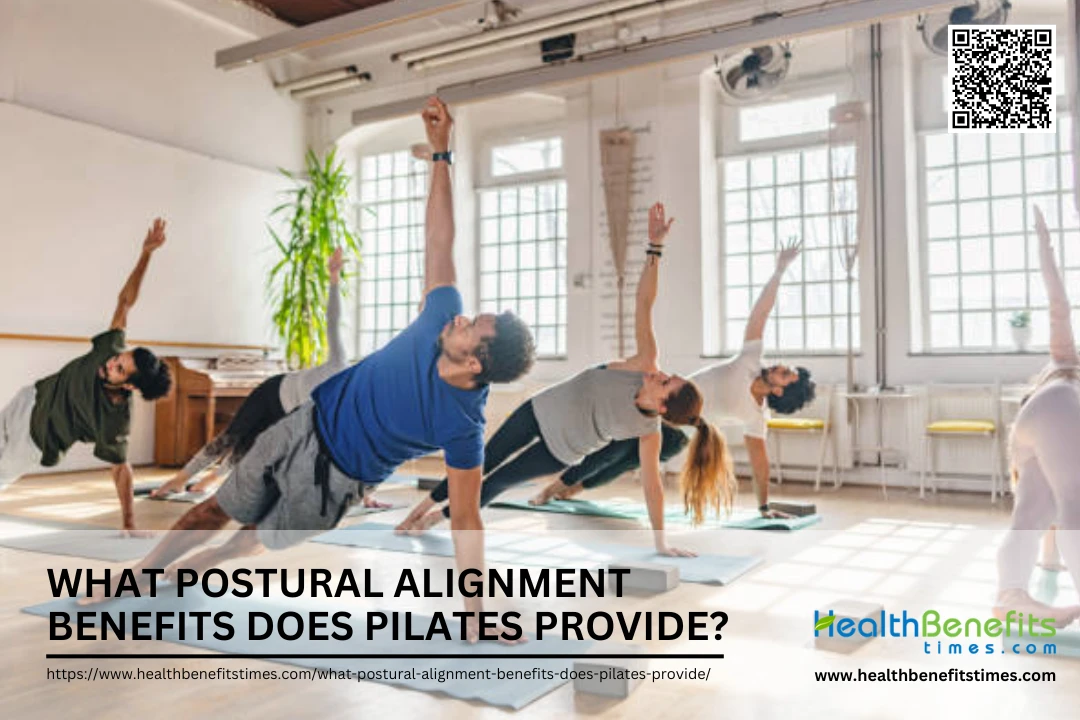 Pilates is a mind-body exercise method that focuses on strengthening the core, enhancing flexibility, and improving postural alignment through precise, controlled movements. Originating as a rehabilitation technique, Pilates has gained widespread recognition for its effectiveness in correcting posture and alleviating musculoskeletal imbalances. Research shows that regular Pilates practice significantly enhances spinal alignment and body awareness, which are critical for maintaining optimal posture (1). Additionally, studies highlight its role in reducing postural deviations, such as forward head posture and rounded shoulders, making it a valuable tool for individuals with sedentary lifestyles (2). Pilates’ emphasis on core stability and muscle engagement further contributes to its ability to rectify alignment issues in various populations, including dancers and athletes (3). Its benefits extend beyond aesthetics, fostering functional improvements in movement and reducing the risk of injury (4). Moreover, Pilates is recognized for promoting proprioception and encouraging body-mind synergy, which play pivotal roles in achieving and maintaining postural alignment (5).
Pilates is a mind-body exercise method that focuses on strengthening the core, enhancing flexibility, and improving postural alignment through precise, controlled movements. Originating as a rehabilitation technique, Pilates has gained widespread recognition for its effectiveness in correcting posture and alleviating musculoskeletal imbalances. Research shows that regular Pilates practice significantly enhances spinal alignment and body awareness, which are critical for maintaining optimal posture (1). Additionally, studies highlight its role in reducing postural deviations, such as forward head posture and rounded shoulders, making it a valuable tool for individuals with sedentary lifestyles (2). Pilates’ emphasis on core stability and muscle engagement further contributes to its ability to rectify alignment issues in various populations, including dancers and athletes (3). Its benefits extend beyond aesthetics, fostering functional improvements in movement and reducing the risk of injury (4). Moreover, Pilates is recognized for promoting proprioception and encouraging body-mind synergy, which play pivotal roles in achieving and maintaining postural alignment (5).
Understanding Postural Alignment
Postural alignment refers to the optimal positioning of the body’s segments relative to one another, maintained by muscular and skeletal balance. Proper alignment not only supports the body’s functionality but also reduces strain on muscles and joints, enhancing overall physical efficiency (6). It is a cornerstone of physical health, essential for activities ranging from basic mobility to athletic performance (7).
Poor posture can lead to numerous health problems, including musculoskeletal pain, reduced mobility, and even cardiovascular and respiratory issues (8). For instance, forward head posture is linked to neck and shoulder discomfort, while hyperlordosis can strain the lower back (9).
Maintaining proper posture involves a combination of awareness, muscular engagement, and ergonomic support (10). Key principles include aligning the spine naturally, engaging core muscles, and evenly distributing weight across the body’s axis.
Key Postural Alignment Benefits of Pilates
Here’s a listicle highlighting the key postural alignment benefits of Pilates, supported by insights and research:
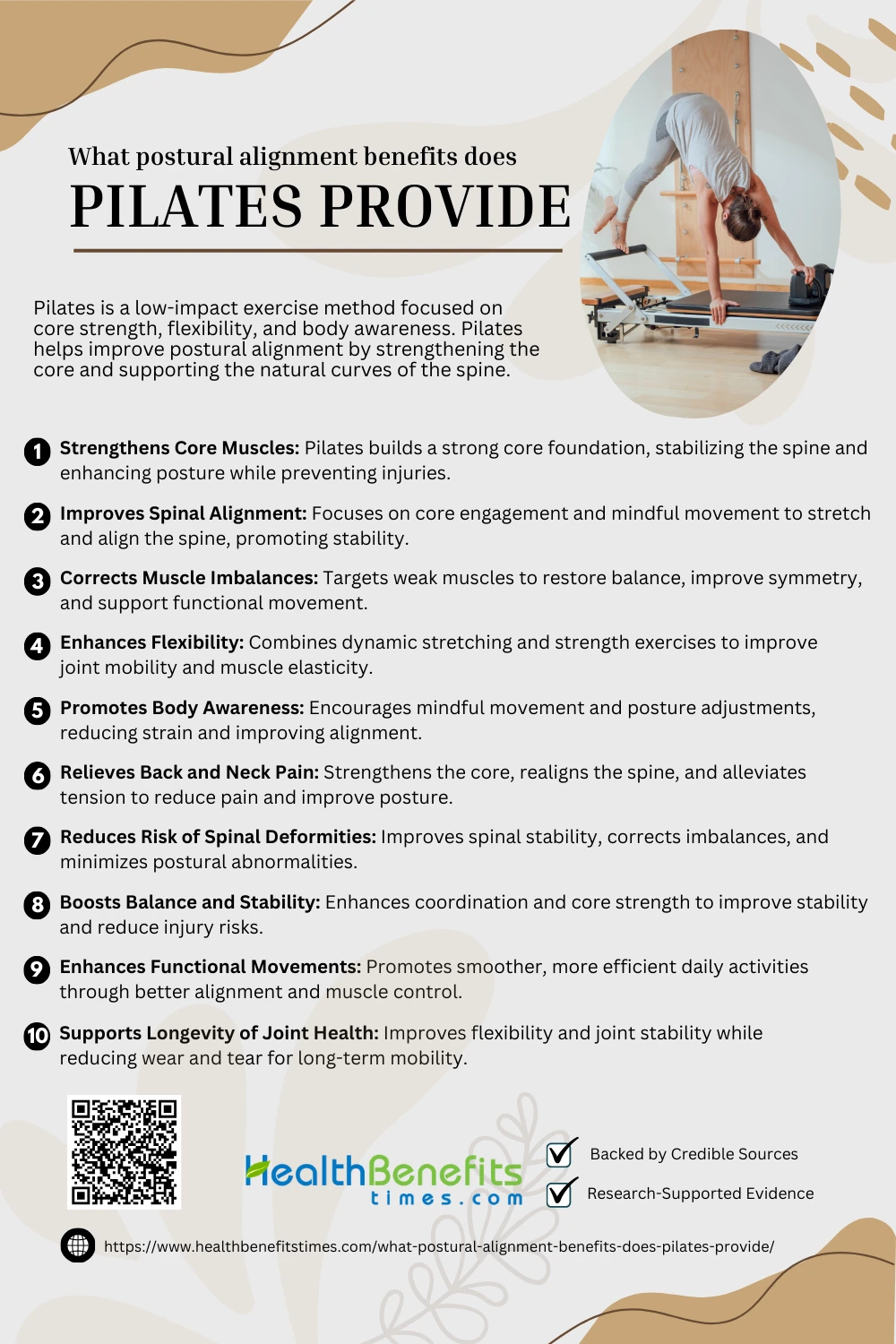 1. Strengthens Core Muscles
1. Strengthens Core Muscles
Pilates is highly effective for strengthening core muscles, a critical component of postural alignment. The practice targets the deep abdominals, back, and pelvic floor, creating a solid foundation for maintaining posture by stabilizing the spine (11). Studies highlight its ability to enhance muscle coordination and prevent back pain (12). Pilates’ focus on proper alignment ensures efficient joint and muscle function, reducing injury risks (13). Research also confirms its role in alleviating spinal deformities (14). Improved flexibility from Pilates further contributes to core stability and posture (15). Regular practice fosters balance and overall body awareness (11), ultimately promoting long-term postural health.
2. Improves Spinal Alignment
Pilates is renowned for improving spinal alignment by emphasizing core engagement and proper posture. The exercises stretch and strengthen spinal muscles, enhancing flexibility and stability (16). By promoting mindful movement, Pilates helps align the spine, reducing strain on back muscles (17). Specialized equipment like the spine corrector facilitates better spinal articulation (18). Additionally, it alleviates spinal deformities by correcting imbalances (14) and enhancing body awareness (15).
3. Corrects Muscle Imbalances
Pilates is an effective method for correcting muscle imbalances by targeting underutilized muscles and promoting balanced body mechanics. Exercises align the head, shoulders, spine, and pelvis, reducing strain and improving symmetry (19). This method enhances functional movement patterns and prevents injuries (20). Regular practice efficiently engages weaker muscles to restore balance (15). Additionally, Pilates reduces spinal deformities and optimizes posture through muscle strengthening (14) and alignment-focused movements (21).
4. Enhances Flexibility
Pilates enhances flexibility by incorporating dynamic stretching and controlled movements that lengthen and strengthen muscles. This dual-action approach improves muscle elasticity and joint mobility, reducing strain (22). Regular practice facilitates spinal articulation and better posture (19). Alignment-focused exercises further prevent stiffness and promote efficient movement (21). Research shows Pilates increases flexibility while minimizing injury risks (14) and optimizing body mechanics (15).
5. Promotes Body Awareness
Pilates enhances body awareness by emphasizing mindful movement and precise control of posture and alignment. This practice enables individuals to detect imbalances and adjust their movements for greater efficiency and reduced strain (19). Increased awareness supports better alignment of muscles and joints (23). Pilates also fosters balance and stability, reducing the risk of injuries (15). Its focus on alignment ensures optimal muscle engagement (21) while improving posture and spinal health (14).
6. Relieves Back and Neck Pain
Pilates is a proven method to relieve back and neck pain by improving posture and strengthening core muscles, including the abdominals and back (19). It realigns the spine and reduces tension in the neck, promoting better posture (24). Exercises focus on flexibility and balance, minimizing strain on the muscles (15). Research also highlights Pilates’ ability to alleviate spinal deformities (14) and enhance spinal elongation (25).
7. Reduces Risk of Spinal Deformities
Pilates is effective in reducing the risk of spinal deformities by enhancing core strength, improving posture, and increasing spinal stability (16). It aligns the spine through controlled movements, minimizing stress on the vertebrae (17). Regular practice corrects postural imbalances, alleviating spinal abnormalities (14). Research shows significant improvement in thoracic and lumbar spine curvatures after consistent Pilates practice (26). Pilates also improves overall flexibility and body awareness (27).
8. Boosts Balance and Stability
Pilates significantly boosts balance and stability by engaging core muscles, improving proprioception, and enhancing postural alignment. It strengthens the lumbopelvic region, essential for maintaining stability during movement (28). Exercises activate muscles that support balance and reduce injury risks (29). Regular practice enhances coordination and alignment, creating efficient movement patterns (21). Research confirms Pilates’ ability to correct imbalances and maintain body equilibrium (14), while supporting long-term postural stability (15).
9. Enhances Functional Movements
Pilates enhances functional movements by improving core strength, alignment, and muscle control. It promotes balanced muscular development, enabling smoother daily activities (30). Exercises focus on proper alignment, reducing strain and optimizing efficiency (21). The practice strengthens the back and limbs, supporting mobility and reducing injury risks (31). Research confirms Pilates enhances posture and balance, vital for functional movements (14). Additionally, it fosters body awareness for coordinated actions (15).
10. Supports Longevity of Joint Health
Pilates supports the longevity of joint health by enhancing flexibility, improving joint stability, and promoting optimal alignment. It reduces arthritis symptoms and increases joint lubrication, essential for long-term mobility (32). Regular practice minimizes stress on joint surfaces and soft tissues, delaying degenerative changes (13). Pilates enhances joint range of motion and functional movement (33). It also fosters muscular balance, reducing injury risks (14) and ensuring physical independence with age (34).
Core Principles of Pilates Related to Posture
Pilates is built on a foundation of principles that not only enhance physical strength and flexibility but also promote optimal postural alignment. By focusing on core strength, controlled movement, and mindful breathing, Pilates helps create a balanced, aligned body that supports both functional movement and long-term posture improvement.
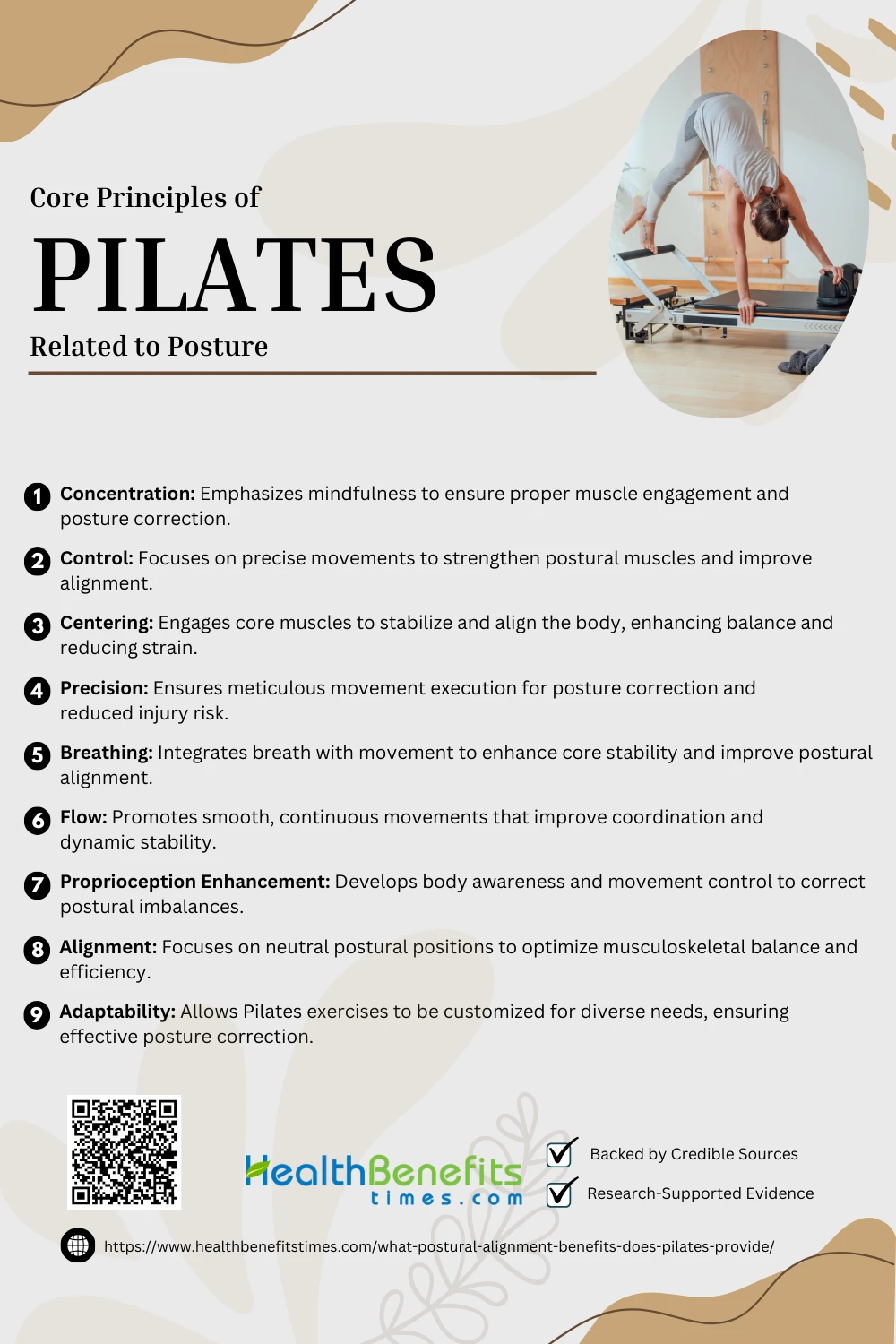 1. Concentration
1. Concentration
Concentration in Pilates is the cornerstone for achieving postural alignment, emphasizing mindfulness during movement execution. This focus ensures proper engagement of stabilizing muscles, enhancing posture and minimizing strain (35). Studies confirm that concentration fosters neuromuscular control, improving core stability and alignment (36). Concentration aids in activating key muscle groups, supporting postural correction (37). Furthermore, it harmonizes breathing and movement, a vital component of Pilates for posture enhancement (38).
2. Control
Control in Pilates emphasizes deliberate, precise movements to maintain stability and alignment during exercises. This principle strengthens postural muscles, reducing the risk of injury. Research highlights its effectiveness in enhancing core stability and dynamic postural balance (39). Controlled movements improve body awareness, essential for posture correction (37). Additionally, it integrates muscle coordination, fostering optimal biomechanical function (36).
3. Centering
Centering is a foundational Pilates principle, emphasizing the activation of the “powerhouse,” or core muscles, to stabilize and align the body. It involves engaging the abdominal, pelvic, and spinal muscles, promoting improved posture and balance (39). This principle enhances body awareness and reduces strain on the musculoskeletal system (37). Research highlights its effectiveness in dynamic stability and posture correction during movement (40).
4. Precision
Precision in Pilates emphasizes meticulous movement execution, fostering optimal posture and alignment. It refines motor control and engages stabilizing muscles, reducing injury risk (41). Studies reveal its role in correcting postural deviations by targeting specific muscle groups (42). Precision ensures balanced force distribution during movements, supporting spinal alignment (39). It enhances proprioception, key to maintaining postural integrity (43). Precision further integrates breath and movement, fostering neuromuscular efficiency (36).
5. Breathing
Breathing in Pilates emphasizes diaphragmatic and lateral rib expansion, integrating breath with movement to enhance posture and muscle engagement (41). It facilitates core stability and reduces tension, contributing to spinal alignment (35). Precision in breathing techniques improves neuromuscular control, critical for postural correction (39). Controlled breathing enhances functional movement efficiency, aligning posture dynamically (37). Research underscores its impact on posture and respiratory health (44).
6. Flow
Flow in Pilates emphasizes smooth, continuous movements, promoting a balanced connection between body and mind (35). This principle enhances movement efficiency and stability, reducing strain on joints while maintaining proper alignment (37). It facilitates postural correction by integrating controlled transitions, fostering dynamic stability (36). Flow encourages muscle coordination and adaptability, critical for maintaining posture in various activities (45). This principle also supports relaxation and focus, improving body awareness and alignment.
7. Proprioception Enhancement
Proprioception enhancement in Pilates focuses on improving body awareness and movement control, crucial for posture correction. This principle engages sensory receptors to refine balance and spatial orientation (46). Studies highlight its role in rehabilitating postural imbalances through sensory-motor integration. Proprioception training improves functional stability, aligning posture during dynamic activities (47). Pilates-based exercises also enhance kinesthetic awareness, crucial for maintaining alignment (48).
8. Alignment
Alignment in Pilates emphasizes achieving and maintaining neutral postural positions, promoting musculoskeletal balance and efficiency (49). This principle targets segmental alignment to minimize stress on joints, as shown in studies on posture correction (39). Research highlights its role in reducing postural asymmetries, such as scoliosis, through targeted exercises (45). By focusing on alignment, Pilates fosters functional movement patterns, optimizing body mechanics (2).
9. Adaptability
Adaptability in Pilates allows exercises to be tailored to individual needs, ensuring effective postural alignment regardless of fitness level (50). This flexibility makes Pilates beneficial for diverse populations, including those with musculoskeletal imbalances (Anderson & Spector, 2000). Research shows its ability to enhance dynamic posture through progressive difficulty (39). The adaptable nature of Pilates integrates well with rehabilitation and athletic training programs (1). This principle also supports neuromuscular re-education for postural stability.
Key Pilates Exercises for Postural Alignment
Here is a detailed explanation of the key Pilates exercises for postural alignment:
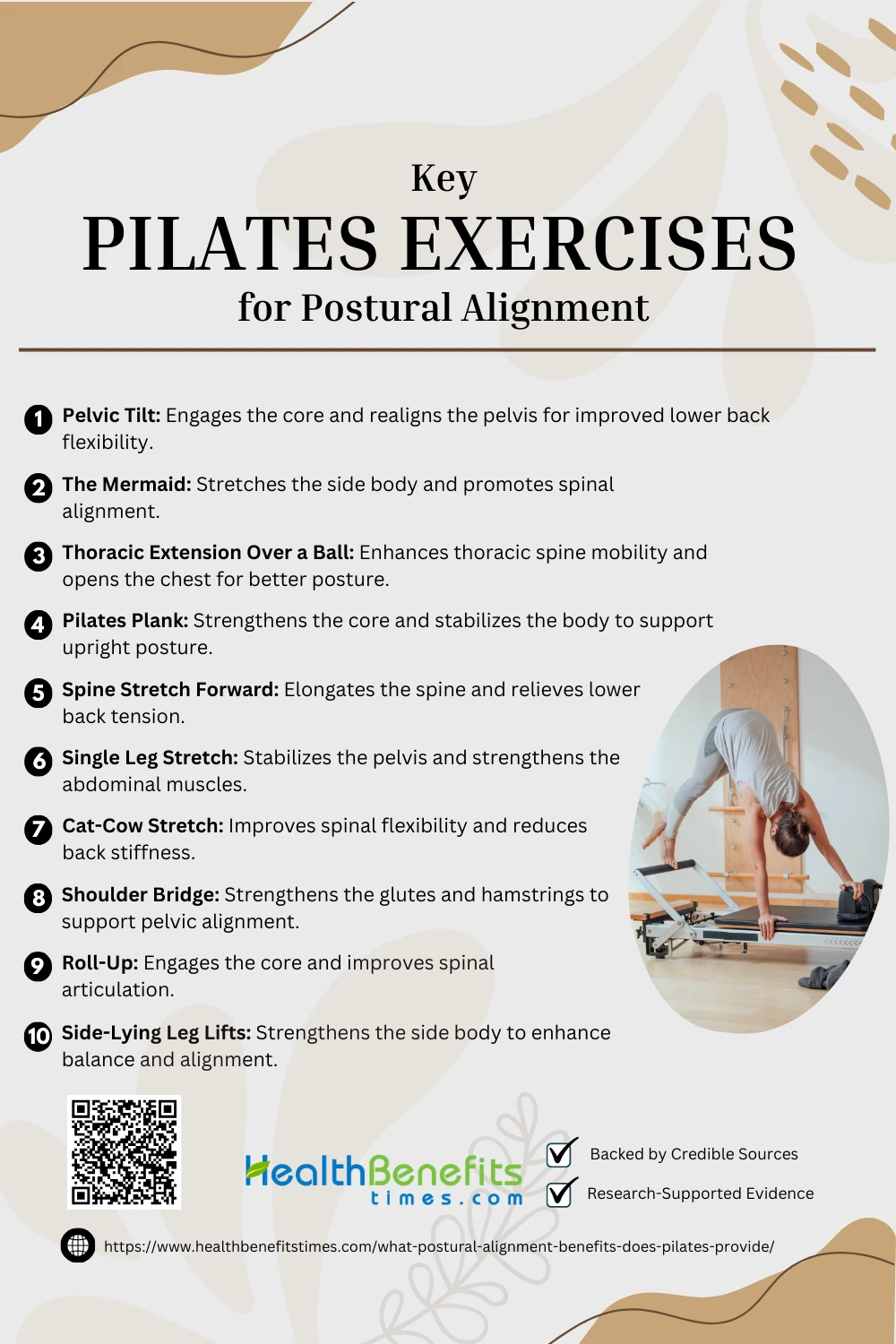 1. Pelvic Tilt
1. Pelvic Tilt
This exercise is a cornerstone of Pilates and helps correct pelvic misalignments. It focuses on engaging the core and gently moving the pelvis to improve lower back flexibility and posture.
How to Perform:
- Lie on your back with knees bent and feet flat on the floor.
- Slowly tilt your pelvis upward, pressing your lower back into the floor.
- Release and repeat.
Benefits:
- Strengthens the lower abdominal muscles.
- Aligns the pelvis with the spine.
2. The Mermaid
This stretch improves lateral flexibility and elongates the spine. It’s particularly useful for releasing tension in the sides of the body.
How to Perform:
- Sit on one hip with both legs bent to the side.
- Extend one arm upward and lean over to the opposite side, creating a stretch along your side body.
Benefits:
- Improves side-body flexibility.
- Encourages spinal alignment.
3. Thoracic Extension Over a Ball
Designed to target the thoracic spine, this exercise is excellent for improving posture in the upper back and shoulders.
How to Perform:
- Sit on the floor with a small Pilates ball under your mid-back.
- Gently extend your upper body over the ball while keeping the core engaged.
Benefits:
- Relieves slouching by opening the chest.
- Increases thoracic spine mobility.
4. Pilates Plank
A classic core-strengthening move, the Pilates plank stabilizes the body and improves overall posture.
How to Perform:
- Place your hands under your shoulders and extend your legs back into a straight line.
- Hold the position while keeping your core engaged and body aligned.
Benefits:
- Strengthens the core, shoulders, and back.
- Promotes upright posture.
5. Spine Stretch Forward
This stretch emphasizes spinal elongation and releases tension in the back.
How to Perform:
- Sit with legs extended straight ahead and feet flexed.
- Reach forward, rounding your back as you stretch toward your toes.
Benefits:
- Improves spinal mobility.
- Reduces tightness in the lower back.
6. Single Leg Stretch
This core-focused exercise stabilizes the pelvis and enhances control over the abdominal muscles.
How to Perform:
- Lie on your back and bring one knee toward your chest while extending the other leg straight.
- Switch legs in a controlled manner.
Benefits:
- Engages the core for pelvic stability.
- Corrects imbalances in posture.
7. Cat-Cow Stretch
This flowing movement sequence is excellent for increasing spinal flexibility and reducing tension.
How to Perform:
- Start on hands and knees in a tabletop position.
- Alternate between arching your back upward (Cat) and dipping it downward (Cow).
Benefits:
- Enhances spinal flexibility.
- Relieves stiffness in the back.
8. Shoulder Bridge
A powerful exercise for strengthening the glutes and hamstrings, which are essential for supporting pelvic alignment.
How to Perform:
- Lie on your back with knees bent and feet flat.
- Lift your hips toward the ceiling, creating a straight line from knees to shoulders.
Benefits:
- Strengthens the posterior chain.
- Helps in maintaining proper pelvic posture.
9. Roll-Up
This slow, controlled movement engages the core and encourages spinal flexibility.
How to Perform:
- Start lying on your back with arms extended overhead.
- Slowly roll your spine up, one vertebra at a time, until you reach a seated position.
Benefits:
- Builds core strength.
- Enhances spinal articulation.
10. Side-Lying Leg Lifts
This exercise focuses on strengthening the side body, including the glutes and obliques, which play a role in postural support.
How to Perform:
- Lie on your side with legs stacked.
- Lift the top leg upward in a controlled motion and lower it back down.
Benefits:
- Strengthens the side body.
- Improves balance and alignment.
Who Can Benefit from Pilates for Postural Alignment?
Here’s a detailed explanation of who can benefit from Pilates for postural alignment:
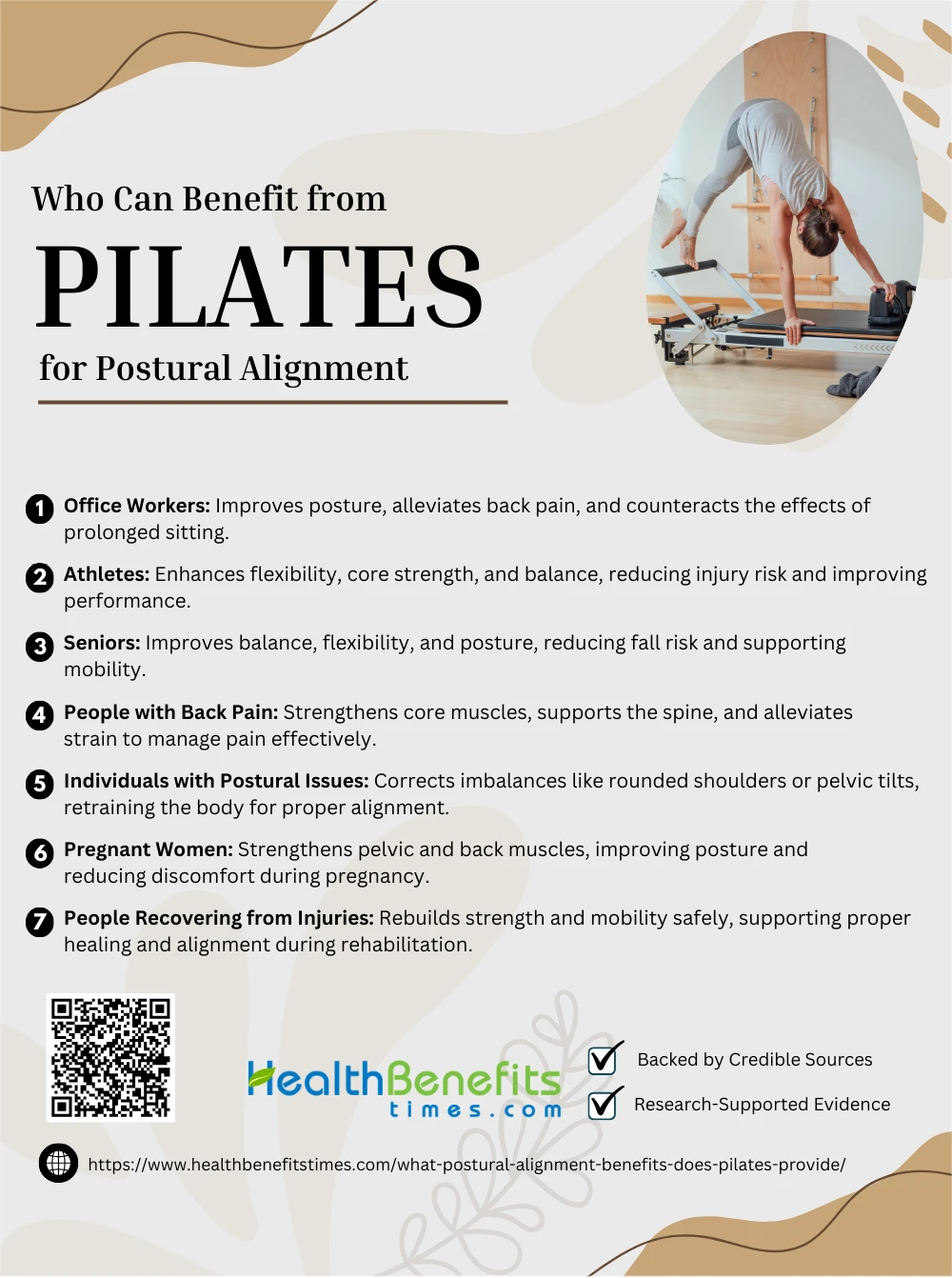 1. Office Workers
1. Office Workers
Office workers often spend long hours sitting at desks, leading to poor posture, slouched shoulders, and back pain. Pilates strengthens the core muscles, including the abdominals and back, which are essential for maintaining an upright posture. It also stretches tight hip flexors and hamstrings, which can become shortened from prolonged sitting. Incorporating Pilates into their routine can help align the spine and reduce discomfort caused by sedentary habits.
2. Athletes
Athletes benefit significantly from Pilates as it enhances flexibility, balance, and core strength. These improvements translate into better performance and reduced risk of injuries. Pilates exercises emphasize body awareness, which helps athletes achieve symmetry and alignment in their movements. By targeting stabilizing muscles, it prevents overuse injuries and ensures efficient motion patterns, making it particularly valuable for runners, dancers, and gymnasts.
3. Seniors
As people age, their risk of falls and joint degeneration increases due to reduced balance and strength. Pilates offers gentle yet effective exercises to improve postural alignment, flexibility, and stability. It also addresses common issues like kyphosis (rounded back) and helps maintain mobility. By focusing on low-impact, functional movements, seniors can build confidence and independence in daily activities.
4. People with Back Pain
Pilates is widely recommended for individuals suffering from chronic or acute back pain. It strengthens the deep core and stabilizing muscles that support the spine, reducing strain on the lower back. Exercises also promote better posture by retraining the body to align correctly, alleviating pressure on nerves and discs. This makes Pilates a non-invasive option for pain management.
5. Individuals with Postural Issues
Pilates addresses specific postural imbalances, such as forward head posture, rounded shoulders, and pelvic tilts. These issues often arise from lifestyle factors like poor ergonomics or prolonged device use. Pilates helps by activating weak muscles and releasing tension in overactive areas. Over time, consistent practice retrains the body to hold itself in proper alignment, preventing long-term structural issues.
6. Pregnant Women
Pregnancy causes shifts in a woman’s center of gravity and can lead to lower back pain and poor posture due to the growing baby bump. Prenatal Pilates focuses on strengthening the pelvic floor, abdominals, and back muscles to support these changes. It also improves flexibility and breathing, which can help during labor. By practicing Pilates, pregnant women can reduce discomfort and maintain better alignment throughout pregnancy.
7. People Recovering from Injuries
Pilates is often integrated into physical therapy programs for its ability to support recovery. It uses controlled movements to rebuild strength and mobility while avoiding undue stress on injured areas. Its focus on alignment ensures that muscles and joints heal properly, reducing the risk of future injuries. This makes Pilates a safe and effective tool for rehabilitation from conditions like sprains, fractures, or surgeries.
Practical Tips for Incorporating Pilates for Posture
1. Start with Neutral Spine Awareness
Starting with neutral spine awareness is crucial for improving posture through Pilates. A neutral spine aligns the body’s natural curves, reducing strain on the back and neck (51). This position serves as a foundation for many Pilates exercises, promoting balance and alignment (15). It can also help in elongating the spine and enhancing flexibility (25). Tools like a spine corrector enhance this alignment further (52).
2. Focus on Core Engagement
Focusing on core engagement during Pilates strengthens the deep abdominal muscles, providing essential support for the spine and improving posture. This engagement enhances stability and balance, reducing strain on the lower back (15). Consistent practice also promotes mobility and balanced muscle development (30). Integrating controlled breathing further activates the core, maximizing alignment benefits.
3. Incorporate Regular Sessions
Incorporating regular Pilates sessions improves posture by consistently strengthening core muscles and reinforcing alignment. Practicing two to three times a week is ideal for noticeable results (11). Integrating it into a fitness routine complements other activities like strength training (53). Gradual progression over weeks leads to better balance and flexibility (54). Regular sessions also embed postural mindfulness into daily life (55).
4. Use Visual Feedback
Using visual feedback during Pilates sessions enhances posture by helping practitioners identify and correct misalignments. Mirrors or recorded videos allow real-time monitoring of form, fostering body awareness (55). This practice strengthens the connection between movement and alignment (Pilates Foundation). Guided online or studio sessions often incorporate visual cues for effective self-correction (11). Visual aids also improve engagement in key exercises (12).
5. Integrate Pilates into Daily Activities
Integrating Pilates into daily activities helps maintain posture by engaging core muscles and promoting alignment during routine tasks like sitting or standing (56). Applying controlled breathing supports relaxation and proper form (55). Focus on mindful movement during daily activities to align the spine and shoulders effectively (15). Stretching periodically throughout the day enhances flexibility and posture (53).
6. Work with a Qualified Instructor
Working with a qualified Pilates instructor ensures correct technique and posture, minimizing the risk of injury and enhancing results. An instructor tailors exercises to individual needs, addressing specific postural imbalances (56). They also provide real-time feedback to improve alignment and movement efficiency (55). Experienced instructors guide safe progression, fostering confidence and skill development (15). Personalized attention accelerates improvements in posture and core strength (53).
7. Focus on Key Exercises
Focusing on key Pilates exercises like the Bridge and Roll-Up enhances posture by strengthening core muscles and improving spinal articulation (57). Incorporating exercises such as the Spine Stretch Forward promotes flexibility and alignment (15). Practicing movements like the Plank targets stability and core strength (31). Regular sessions reinforce posture correction and reduce imbalances (54).
Conclusion
In conclusion, Pilates offers numerous postural alignment benefits by strengthening the core, improving flexibility, and promoting body awareness. This low-impact exercise method encourages proper alignment of the spine and pelvis, helping to alleviate pain and reduce the risk of injury. By focusing on controlled movements and mindful breathing, Pilates trains the body to maintain better posture in everyday activities. Over time, it can enhance balance, stability, and overall physical symmetry, making it an excellent practice for individuals seeking to improve their posture and overall well-being.
References:
- Kloubec, J. A. (2010). Pilates for improvement of muscle endurance, flexibility, balance, and posture. The Journal of Strength & Conditioning Research. LWW
- Cruz-Ferreira, A., Fernandes, J., & Kuo, Y. L. (2013). Does pilates-based exercise improve postural alignment in adult women? Taylor & Francis. Taylor & Francis
- McMillan, A., Proteau, L., & Lèbe, R. M. (1998). The effect of Pilates-based training on dancers’ dynamic posture. Journal of Dance Medicine & Science. IngentaConnect
- Galea, M. P. (2009). Sagittal spinal posture after Pilates-based exercise in healthy older adults. Spine Journal. LWW
- Guimarães, A. N., Okazaki, V. H. A., et al. (2024). The effect of exercise on postural alignment: A systematic review. Journal of Bodywork and Movement Therapies. ScienceDirect
- Young, M., & Michael, L. (2002). A review on postural realignment and its muscular and neural components. British Journal of Sports Medicine. ResearchGate
- Oliver, S. (2009). Alignment in early movement education. Journal of Physical Education, Recreation & Dance. Taylor & Francis
- Alrowili, A. N., Alanazi, K. H. H., et al. (2024). Physiotherapy for postural disorders: A comprehensive review. Journal of International Clinical Research. JICRCR
- Smart Jr., L. J., & Smith, D. L. (2001). Postural dynamics: Clinical and empirical implications. Journal of Manipulative and Physiological Therapeutics. Elsevier
- Nashner, L. M., & McCollum, G. (1985). The organization of human postural movements. Behavioral and Brain Sciences. Cambridge
- Club Pilates. (2024). Pilates for Posture: Aligning Your Body for Better Health..
- (2021). 19 Pilates Benefits Backed By Science..
- Room for Movement Pilates Studio. (2020). What is Good Alignment?.
- (2024). Effects of Pilates on Body Posture: A Systematic Review..
- Premium Pilates. (2024). Can Pilates Improve Your Posture?.
- National Center for Biotechnology Information. (2024). Effects of Pilates Exercises on Spine Deformities and Posture..
- Village Gym. (2024). Pilates for Back Pain: Better Flexibility & Spinal Alignment..
- Complete Pilates. (2024). Pilates Ladder Barrel and Spine Corrector Exercises..
- The Pilates Circuit. (2024). Is Pilates Good for Posture?
- (2024). LIT Axis: Resistance Band Workout to Target Muscle Imbalances..
- Adele’s Pilates. (2024). Importance of Proper Alignment in Reformer Pilates.
- (2024). How Pilates Builds Flexibility.
- Lucy Evans Academy. (2024). Mindful Movement: How Pilates Enhances Body Awareness.
- Complete Pilates. (2023). Pilates for Neck Pain: The Benefits + Exercises..
- Pilates Anytime. (2024). Aligning the Spine: Pilates for Scoliosis Care.
- (2021). The Impact of 10 Weeks of Pilates on Thoracic and Lumbar Curvatures.
- Complete Pilates. (2024). Pilates for Posture Correction.
- National Center for Biotechnology Information. (2024). Effects of Pilates Training on Lumbo-Pelvic Stability and Flexibility.
- Pilates Anytime. (2024). Pilates for Balance for Seniors.
- Better Health Channel. (2024). Pilates – Health Benefits.
- One Life Fitness. (2024). Understanding the Power of Pilates: A Deep Dive into Its Benefits.
- Aimee Victoria Long. (2024). The Benefits of Incorporating Pilates into Your Longevity Program.
- In Motion Physical Therapy. (2024). Pilates for Osteoarthritis: A Physical Therapist’s Guide.
- Upgrade Pilates. (2024). Unlocking Longevity: How Pilates Can Help You Live Longer.
- Shah, S. (2013). Pilates exercises. International Journal of Physiotherapy and Research.
- Wells, C., et al. (2012). Defining Pilates exercise. Complementary Therapies in Medicine.
- Muscolino, J. E., & Cipriani, S. (2004). Pilates and the “powerhouse”. Journal of Bodywork and Movement Therapies. LearnMuscles
- Kloubec, J. A. (2005). Pilates exercises for posture improvement. Search ProQuest.
- Krawczky, B., et al. (2016). The impact of Pilates exercises on the postural alignment of healthy adults. Revista Brasileira de Medicina do Esporte.
- Marques, N. R., et al. (2013). EMG activity of trunk stabilizer muscles during Centering Principle of Pilates Method. Journal of Bodywork and Movement Therapies.
- Khan, A. A., Siddiqui, H. A., Rastogi, K., & Ali, A. (2023). Pilates: Enhancing musculoskeletal health through integrated movement. ResearchGate.
- Ivanivna, V. N., & Vasylivna, P. O. (2023). The essence of the Pilates system principles. EU-Conf Proceedings. EU-Conf
- Dev, R. D. O., et al. (2024). Effects of Pilates on body posture: A systematic review. Archives of Rehabilitation. ScienceDirect
- Cancelliero-Gaiad, K. M., Ike, D., Pantoni, C. B. F., et al. (2014). Respiratory pattern of diaphragmatic breathing and Pilates breathing in COPD subjects. Brazilian Journal of Physical Therapy. SciELO
- Anderson, B. (2024). Pilates rehabilitation. Integrative Therapies in Rehabilitation. Taylor & Francis
- Nascimento, M. M., et al. (2012). The Pilates method to improve body balance in the elderly. ResearchGate. ResearchGate
- Garcia-Falgueras, A. (2016). An introduction to proprioception concept in Pilates and yoga. British Journal of Medicine and Medical Research. ResearchGate
- Yaali, R., et al. (2024). Effects of Pilates exercise on static balance and proprioception. SAGE Journals. SAGE
- Kim, D. H., & Lim, J. M. (2020). The effect of Pilates core exercise on body alignment. AOSPT. SportsPT
- Baptista, R. R., et al. (2012). Effectiveness of Pilates method for the posture and flexibility of women with hyperkyphosis. edu
- (2016). The Pilates Neutral Spine Position.
- Pilates Direct. (2024). How To Use A Pilates Spine Corrector.
- (2024). Should You Add Pilates to Your Workout?.
- (2018). Pilates Benefits: Better Posture and Balance.
- (2024). Bringing Pilates Into Everyday Life.
- Core Fitness. (2024). Pilates for Beginners: Integrating Pilates into Everyday Life.
- Village Pilates. (2024). Graceful Alignment: Achieving Better Posture with Pilates..

